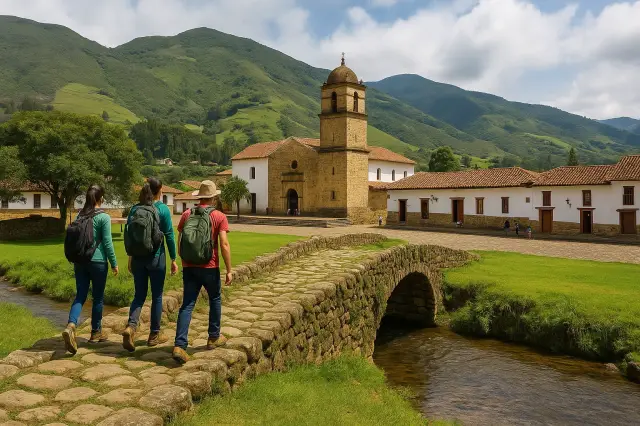Holiday tourism in Colombia has become a trend that is transforming the way Colombians travel and discover their own country. More and more people are taking advantage of long weekends to explore off-the-beaten-path destinations , far from mass tourism, where nature, culture, and authenticity become the main attractions.
As national holidays boost domestic travel, rural communities and less-visited municipalities begin to experience significant economic and social growth. This article explores how holidays benefit local tourism, highlights the most appealing alternative destinations, and examines the impact of this trend on the country's identity and sustainability.
The rise of domestic tourism during holidays in Colombia
Colombia has one of the most official holidays in Latin America, and this has been a natural driver for domestic tourism. According to the Ministry of Commerce, Industry and Tourism, short weekend trips have increased significantly since 2022, driven by the need to disconnect, the ease of ground transportation, and the search for more authentic experiences.
Among the most influential factors are:
The long weekends scheduled by the Emiliani Law , which move many dates to Mondays.
Diversification of the regional tourism offer.
The rise of sustainable and community-based tourism .
The increase in digital connectivity that allows for easy planning of getaways.
Unlike peak season tourism, holiday tourism has a special characteristic: it distributes the flow of visitors throughout the year, helping to revitalize lesser-known regions.
Unconventional destinations that are growing thanks to holiday tourism
Across the country, towns that were previously not on traditional tourist routes are now receiving visitors seeking tranquility, nature, and local culture. Here are some of the most notable:
1. Monguí, Boyacá
Considered one of the most beautiful towns in Colombia , Monguí combines history, colonial architecture, and páramo landscapes. During holidays, tourists from Bogotá and Tunja choose it to relax amidst mountains and stone bridges. Handicrafts, especially leatherwork, have flourished thanks to this influx of tourists.
2. San Antero, Córdoba
Famous for its Donkey Festival , this coastal destination is emerging as an alternative to traditional beach resorts. Its tranquil beaches and ecotourism opportunities in the Caimanera marsh make it an ideal spot for those seeking a unique experience in the Colombian Caribbean.
3. Jericho, Antioquia
The rise of religious and nature tourism has put Jericó on the map. It's an ideal holiday destination, with hiking, history, and a charming Antioquian village atmosphere that captivates visitors.
4. El Cocuy, Boyacá
For adventure lovers, El Cocuy National Natural Park is perfect for long weekend getaways. Glacier hikes, wildlife viewing, and breathtaking high-altitude landscapes make it a leading ecotourism destination in Chile.
5. San José del Guaviare
Holiday tourism has also opened the door to archaeological and nature tourism . The cave paintings, rivers with unique rock formations, and the hospitality of its people make it an emerging destination.
6. Guatapé, Antioquia
Although more widely known, it remains a clear example of how holidays boost local economies. During every long weekend, thousands of Colombians climb the famous Piedra del Peñol, providing a boost to hotels, restaurants, and tour guides.
How holidays benefit local economies
Holidays not only promote rest and recreation, but also represent an economic engine for small and medium-sized communities. Some specific benefits include:
Increased hotel occupancy during short seasons.
Boosting local commerce : gastronomy, transport, crafts.
Strengthening temporary and community employment .
Promotion of regional culture through festivals, fairs and traditional activities.
According to ProColombia, alternative destinations registered a 20% growth in visits during the 2024 holidays, and the trend continues to increase for 2025.
Sustainable tourism and responsible holidays
The growth of tourism during holidays also presents significant challenges. Communities and travelers must adopt sustainable practices to preserve the natural and cultural environment.
Among the most valuable recommendations are:
Travel in small groups and respect ecological limits.
Buy local products directly from the artisans.
Avoid using single-use plastics.
Participate in community tourism experiences.
Promote environmental education and respect for local traditions.
Sustainable tourism not only protects natural heritage, but also strengthens regional identity and pride.
Holidays that boost tourism in Colombia
Some of the most popular holidays for travel in 2025 include:
| Date | Celebration | Type of holiday |
|---|---|---|
| January 6 | Three Kings Day | Religious |
| March 24 | Saint Joseph's Day | Religious |
| April 17 | Holy Thursday | Religious |
| April 19 | Holy Saturday | Religious |
| July 20 | Independence Day | National |
| August 7 | Battle of Boyacá | Patriotic |
| October 13 | Columbus Day | Civic |
| December 8 | Feast of the Immaculate Conception | Religious |
You can check all the updated holidays in the 2025 Colombia holiday calendar to plan your next trips.
Unconventional destinations and unforgettable experiences
Holiday tourism is helping Colombians reconnect with their country, rediscover their roots, and appreciate the cultural heritage of each region. Traveling during holidays has become a way to enjoy authentic experiences, boost local economies, and contribute to a balance between development and sustainability.
Thus, holidays in Colombia are much more than just days off: they are opportunities to explore, learn and strengthen ties with our natural and cultural diversity.
To learn more about special dates, celebrations, and unique destinations in the country, visit the official blog of CalendarioDeColombia.com , where you will find articles about historical events, regional festivities, and Colombian customs.
